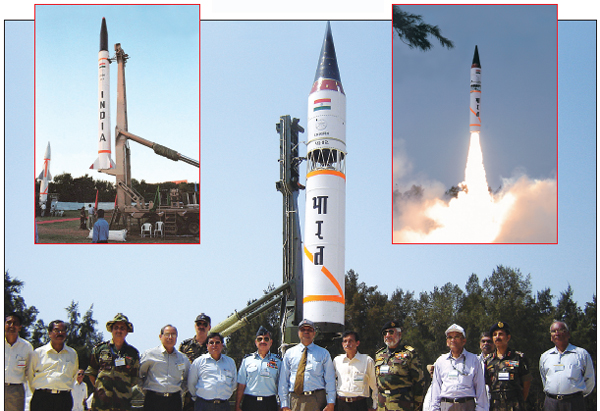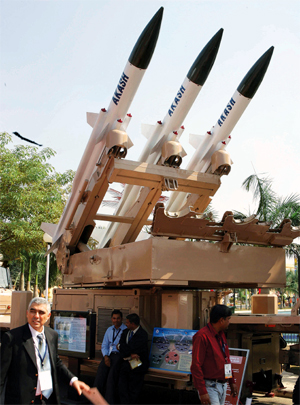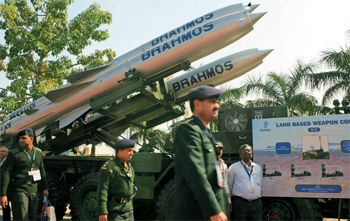|
The past decades have witnessed phenomenal surges
in missile technology and intrusions into outer
space. India, however did not have a credible
missile programme by means of which it could boast
of a sturdy arsenal of missile systems of that
point. India's missile programme can be stated
to be an offshoot of its space programme, beginning
1967. Subsequently, in 1972, Rohini- a 560 two-stage,
solid propulsion sounding rocket was developed
and test fired, capable of reaching an altitude
of 334 km with a 100 kg payload. India first launched
its small 17-tonne SLV-3 space booster (300km/40
kg) in 1979 and thereafter successfully injected
the 35 kg Rohini I satellite into near-earth orbit
in 1980. By 1987, an augmented booster, the 35-tonne
ASLV (4,000 Km /150kg in low earth orbit), which
primarily are three SLV-3's strapped together,
had begun flight testing.
In what could be described as a 'decisive shift'
in missile development plans, the missile capability
of Indian armed forces received a major fillip
from Defence Research and Development Organisation
(DRDO) following the launching of the Integrated
Guided Missile Development Programme (IGMDP) in
1983. The principal aim was to develop a family
of strategic and tactical guided missiles based
on local design and development for three defence
services. DRDO accorded particular priority to
development of sophisticated guidance technology.
The Indian missile arsenal boasts a range of
systems and the current thrust areas of the DRDO
include Internal Ram Rocket Engines, Multi-target
tracking capability, Homing guidance using seeker
and networking of radars. Concurrently, the DRDO
has consistently worked towards enhancing and
upgrading the following missile system further:

Agni-I is a single stage, solid fuel,
road and rail mobile, medium-range ballistic missiles
(MRBM) using solid propulsion upper stage, derived
from Prithvi, essentially to prove the re-entry
structure, control and guidance. The strap-down
inertial navigation system adopts explicit guidance—attempted
for the first time globally. Using carbon composite
structure for protecting payload during its re-entry
phase, the first flight was conducted in May 1989,
thus establishing the re-entry technology and
precise guidance to reach the specific targets.
This shorter ranger missile is specially designed
to strike targets in Pakistan.
Agni II is an operational version of Agni
I and is an intermediate range ballistic missile
(IRBM) with two solid fuel stages and a Post Boost
Vehicle (PBV) integrated into the missile’s Reentry
Vehicle (RV) with mobile launch capability test-fired
in April 1999.
The range for Agni II is more than 2000 km. Quick
deployment of the Agni II was possible, by building
on the earlier Agni-TD programme that provided
proven critical technologies and designs required
for long range ballistic missiles. The Agni II
missile was last test fired in May 2009. A new
variant of the Agni II called the Agni IIIA is
presently under development.
Additionally, Agni III, an intermediate-range
ballistic missile was developed by India as the
successor to Agni II. Intended to be a two-stage
ballistic missile capable of nuclear weapons delivery,
it is touted as India’s nuclear deterrent against
China. The missile is likely to support a wide
range of warhead configurations, with a 3,500
km range and a total payload weight of 2490 kg.
The two-stage solid fuel missile is compact and
small enough for easy mobility and flexible deployment
on various surface/sub-surface platforms. The
last development test of Agni III was conducted
in August 2009 before being handed over to the
army for user trails.
Agni V, believed to be an upgraded version
of the Agni III is currently being worked upon
by the DRDO. The inter-continental ballistic missile
shall have a range of about 5000-6000 km and the
first test flight is expected around 2010 end.
Agni V would be a three stage solid fueled missile
with composite motor casing in the third stage.
Agni V will be able to carry multiple warheads
and would also display countermeasures against
anti-ballistic missile systems.
The Trishul (Trident) is a short range,
quick reaction, all weather surface-to-air missile
designed to counter a low-level attack. In fact,
Trishul was one of the longestrunning DRDO missile
development programme. It can also be used as
an anti-sea skimmer from a ship against low flying
attacking missiles. The missile can engage targets
like aircraft and helicopters, flying between
300 m/s and 500 m/s by using its radar commandto-
line-of-sight guidance. Powered by a two-stage
solid propellant system, with a highly powered
HTBP-type propellant similar to the ones used
in the Patriot, the Trishul has necessary electronic
counter-counter measures against all known aircraft
jammers. Trishul, with its quickest reaction time,
high frequency operation, high manoeuverability,
high lethal capability and multi-roles for three
services, is state-of-the-art system providing
considerable advantage to the Indian armed forces.
 The
Akash system is a medium range surface-to-air
missile with multi-target engagement capability.
It can carry a 55-kg multiple warhead capable
of targeting five aircraft simultaneously up to
25 km and is said to be comparable to the US Patriot
as an air defence missile. It uses high-energy
solid propellant for the booster and ram-rocket
propulsion for the sustainer phase. The propulsion
system provides higher level of energy with minimum
mass, compared to conventional solid/ liquid rocket
motor, which has better performance with minimum
weight of the missile. It has a dual mode guidance,
initially on command mode from phased array radar
and later radar homing guidance with unique software
developed for high accuracy. The phased array
radar provides capability for multiple target
tracking and simultaneous deployment of missiles
to attack four targets at the same time, in each
battery. The
Akash system is a medium range surface-to-air
missile with multi-target engagement capability.
It can carry a 55-kg multiple warhead capable
of targeting five aircraft simultaneously up to
25 km and is said to be comparable to the US Patriot
as an air defence missile. It uses high-energy
solid propellant for the booster and ram-rocket
propulsion for the sustainer phase. The propulsion
system provides higher level of energy with minimum
mass, compared to conventional solid/ liquid rocket
motor, which has better performance with minimum
weight of the missile. It has a dual mode guidance,
initially on command mode from phased array radar
and later radar homing guidance with unique software
developed for high accuracy. The phased array
radar provides capability for multiple target
tracking and simultaneous deployment of missiles
to attack four targets at the same time, in each
battery.
Another missile under IGMDP development is the
Nag, an antiarmor weapon employing sensor
fusion technologies for flight guidance first
tested in November 1990. The Nag is a third generation
‘fire-and-forget’ anti-tank missile developed
in India with a range of 4 to 8 km. Nag uses Imaging
Infra-Red (IIR) guidance with day and night capability.
Mode of launch for the IIR seeker is LOBL (Lock
on before Launch). Nag was successfully test fired
in August 2008 marking the completion of the developmental
tests. Nag is expected to be the first weapon
of its kind to be inducted into the army by December
2009. The Army urgently needs the more advanced
Nag to improve kill probability as the missile
using a high explosive warhead to penetrate the
armor in modern tanks.
The Prithvi is a surface-tosurface battle
field missile using a single state, twin-engine
liquid propulsion system and strap-down inertial
guidance with real-time software incorporated
in the onboard computer to achieve the desired
accuracy during impact. Prithvi demonstrates higher
lethal effects as compared to any equivalent class
of missiles in the world. Prithvi could well be
termed as a unique missile since it displays manoeuverable
trajectory and high level capability with field
interchangeable warheads. Its accuracy has been
demonstrated in the development flight trials.
Flight trails for the air force has been completed
and the system is now being configured for launching
from ship, thereby increasing its capability as
a sea mobile system.
Significant additions also include the Multi-Barrel
Rocket System PINAKA, an area weapon system
to supplement the existing artillery gun at ranges
beyond 30 km, having quick reaction time and high
rate of fire has been accepted by the user after
extensive trials. BrahMos being jointly developed
with Russia, is a supersonic cruise missile that
can be launched from submarines, ships, aircraft
or land.
 BrahMos
is among the fastest supersonic cruise missiles
in the world, at speeds ranging between Mach 2.5
to 2.8, being about three and a half times faster
than the American subsonic Tomahawk cruise missile.
Although BrahMos is primarily an anti-ship missile,
it is also capable of engaging land-based targets.
DRDO has claimed that BrahMos would be able to
start deliveries of the 240 missiles ordered by
the army in two years from now as per the original
schedule. It was reported in January 2009 that
two Indian Air Force Sukhoi- 30MKI fighter jets
were sent to Russia for a retrofit programme that
would enable them to launch the aerial version
of the BrahMos missile. BrahMos
is among the fastest supersonic cruise missiles
in the world, at speeds ranging between Mach 2.5
to 2.8, being about three and a half times faster
than the American subsonic Tomahawk cruise missile.
Although BrahMos is primarily an anti-ship missile,
it is also capable of engaging land-based targets.
DRDO has claimed that BrahMos would be able to
start deliveries of the 240 missiles ordered by
the army in two years from now as per the original
schedule. It was reported in January 2009 that
two Indian Air Force Sukhoi- 30MKI fighter jets
were sent to Russia for a retrofit programme that
would enable them to launch the aerial version
of the BrahMos missile.
When compared with other weapon systems of its
class, BrahMos continues to remain the most cost
effective option. It is plausible to assume that
cruise missiles constitute an important element
of the military arsenals for many nations including
India owing to the costs, both absolute and in
comparison with other aerial weapons. Thus the
contribution of the BrahMos to India’s defence
is fundamentally significant in a quest to maximise
its firepower potential to counter a future military
attack. In fact, India is the only country in
the world to have inducted the supersonic landattack
cruise missile in its army.
Yet another cruise missile, the Nirbhay was
announced in 2007—a subsonic missile with a range
of 1000 km. Capable of being launched from multiple
platforms on land, sea and air, the missile is
being developed to be tested in 2009. Nirbhay
will be a terrain hugging, stealth missile capable
of delivering 24 different types of warheads depending
on mission requirements and will use inertial
navigation system for guidance. In fact, Nirbhay
will supplement BrahMos in the sense that it would
enable delivery of warheads farther than the 300
km range of BrahMos, according to reports.
In 2008, New Delhi announced the end of the IGMDP
with the focus now shifting towards serial production
of missiles developed under this programme. Notwithstanding
that the need for a systematically planned long-term
doctrine has to be underlined, given that future
wars would be autonomous and network centric,
India needs more BrahMos like weapons systems
which has emerged as the perfect strike weapon
with a fine combination of speed, precision, power,
kinetic energy and reaction time attributes.
Delhi has also taken steps toward achieving submarine
launched ballistic missile capability, with the
first test of the K-15 (Sagarika) taking place
in February 2008 from a submerged barge with a
range of 750 km. Moreover, a landbased variant
of the K-15 Sagarika named Shaurya, which
can be stored in underground silos for longer
time and can be launched using gas canisters as
booster was successfully test-fired in November
2008. This nuclear-capable missile aims to enhance
India’s second-strike capability and the Indian
Navy plans to introduce the missile into service
by the end of 2010. Sagarika missile is being
integrated with India’s nuclearpowered Arihant
class submarine that began sea trials in July
2009.
Also under development is the sea-based Dhanush,
which has been tested several times in recent
years believed to be a short-range, sea-based,
liquid-propellant ballistic missile—perhaps a
naval variant of the Prithvi series. According
to reports, the possibility of a two stage version,
the first being solid fueled and the second liquid
fueled is expected—thus providing the missile
with a maximum range of approximately 300 km.
It would be apposite to conclude by stating
that India’s missile programme represents an iconic
image demonstrating sovereignty and self-reliance
vis-à-vis its technological achievements. Resultant
of nearly three decades of research, India’s guided
missile programme has assumed a self-sustaining
character and become fundamentally crucial to
New Delhi’s proposed minimal deterrent.
The author is a Research
Fellow at the Centre for Land Warfare Studies
(CLAWS).
|